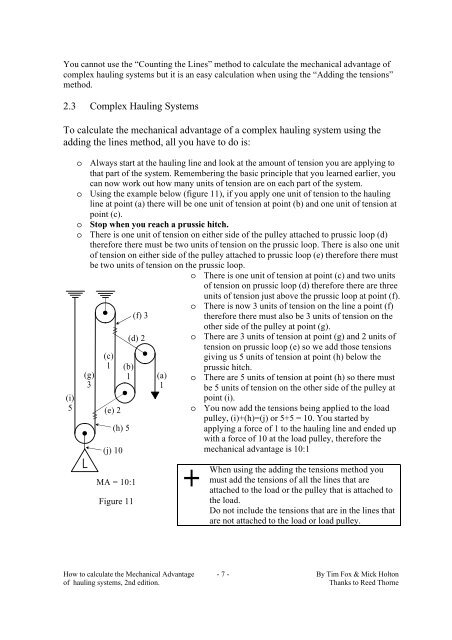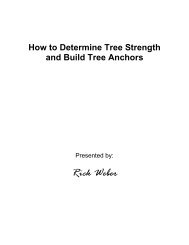Mechanical Advantage Paper.pdf
Mechanical Advantage Paper.pdf
Mechanical Advantage Paper.pdf
You also want an ePaper? Increase the reach of your titles
YUMPU automatically turns print PDFs into web optimized ePapers that Google loves.
You cannot use the “Counting the Lines” method to calculate the mechanical advantage of<br />
complex hauling systems but it is an easy calculation when using the “Adding the tensions”<br />
method.<br />
2.3 Complex Hauling Systems<br />
To calculate the mechanical advantage of a complex hauling system using the<br />
adding the lines method, all you have to do is:<br />
(i)<br />
5<br />
o Always start at the hauling line and look at the amount of tension you are applying to<br />
that part of the system. Remembering the basic principle that you learned earlier, you<br />
can now work out how many units of tension are on each part of the system.<br />
o Using the example below (figure 11), if you apply one unit of tension to the hauling<br />
line at point (a) there will be one unit of tension at point (b) and one unit of tension at<br />
point (c).<br />
o Stop when you reach a prussic hitch.<br />
o There is one unit of tension on either side of the pulley attached to prussic loop (d)<br />
therefore there must be two units of tension on the prussic loop. There is also one unit<br />
of tension on either side of the pulley attached to prussic loop (e) therefore there must<br />
be two units of tension on the prussic loop.<br />
(g)<br />
3<br />
(c)<br />
1<br />
(e) 2<br />
(d) 2<br />
(b)<br />
1<br />
(h) 5<br />
(j) 10<br />
MA = 10:1<br />
Figure 11<br />
(f) 3<br />
(a)<br />
1<br />
o There is one unit of tension at point (c) and two units<br />
of tension on prussic loop (d) therefore there are three<br />
units of tension just above the prussic loop at point (f).<br />
o There is now 3 units of tension on the line a point (f)<br />
therefore there must also be 3 units of tension on the<br />
other side of the pulley at point (g).<br />
o There are 3 units of tension at point (g) and 2 units of<br />
tension on prussic loop (e) so we add those tensions<br />
giving us 5 units of tension at point (h) below the<br />
prussic hitch.<br />
o There are 5 units of tension at point (h) so there must<br />
be 5 units of tension on the other side of the pulley at<br />
point (i).<br />
o You now add the tensions being applied to the load<br />
pulley, (i)+(h)=(j) or 5+5 = 10. You started by<br />
applying a force of 1 to the hauling line and ended up<br />
with a force of 10 at the load pulley, therefore the<br />
mechanical advantage is 10:1<br />
+<br />
When using the adding the tensions method you<br />
must add the tensions of all the lines that are<br />
attached to the load or the pulley that is attached to<br />
the load.<br />
Do not include the tensions that are in the lines that<br />
are not attached to the load or load pulley.<br />
How to calculate the <strong>Mechanical</strong> <strong>Advantage</strong> - 7 - By Tim Fox & Mick Holton<br />
of hauling systems, 2nd edition.<br />
Thanks to Reed Thorne



